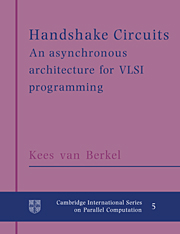Book contents
- Frontmatter
- Contents
- Foreword
- Preface
- 0 Introduction
- 1 Introduction to Tangram and handshake circuits
- 2 Examples of VLSI programs
- 3 Handshake processes
- 4 Handshake circuits
- 5 Sequential handshake processes
- 6 Tangram
- 7 Tangram → handshake circuits
- 8 Handshake circuits → VLSI circuits
- 9 In practice
- A Delay insensitivity
- B Failure semantics
- Bibliography
- Glossary of symbols
- Index
5 - Sequential handshake processes
Published online by Cambridge University Press: 14 January 2010
- Frontmatter
- Contents
- Foreword
- Preface
- 0 Introduction
- 1 Introduction to Tangram and handshake circuits
- 2 Examples of VLSI programs
- 3 Handshake processes
- 4 Handshake circuits
- 5 Sequential handshake processes
- 6 Tangram
- 7 Tangram → handshake circuits
- 8 Handshake circuits → VLSI circuits
- 9 In practice
- A Delay insensitivity
- B Failure semantics
- Bibliography
- Glossary of symbols
- Index
Summary
Introduction
So far the quiescent trace set of a handshake process was specified in one of the following forms: by enumeration, by a predicate, by a state graph, or by parallel composition of other handshake processes.
For many handshake processes none of the above forms may be convenient. An example of such a process is the process that first behaves like P and then, “after successful termination of P”, behaves like Q. Of course, such sequential composition of the handshake processes P and Q requires a notion of successful termination of a process. A sequential handshake process is a handshake process in which that notion is incorporated.
The aim of this chapter is to develop a model for sequential handshake processes and a calculus for these processes. An important application of this calculus is the description of the handshake components required for the compilation of Tangram. Another application is the semantics of Tangram itself.
Sequential handshake processes
A sequential handshake process is a handshake process, some of whose traces are designated as terminal traces, i.e. traces that lead to successful termination. In a sequential composition these terminal traces can be prefixed to traces of the subsequent sequential handshake process.
Let T denote the set of quiescent traces and let U denote the set of terminal traces of sequential handshake process P. Sets T and U must satisfy a number of conditions, which are introduced informally.
- Type
- Chapter
- Information
- Handshake CircuitsAn Asynchronous Architecture for VLSI Programming, pp. 89 - 110Publisher: Cambridge University PressPrint publication year: 1994



